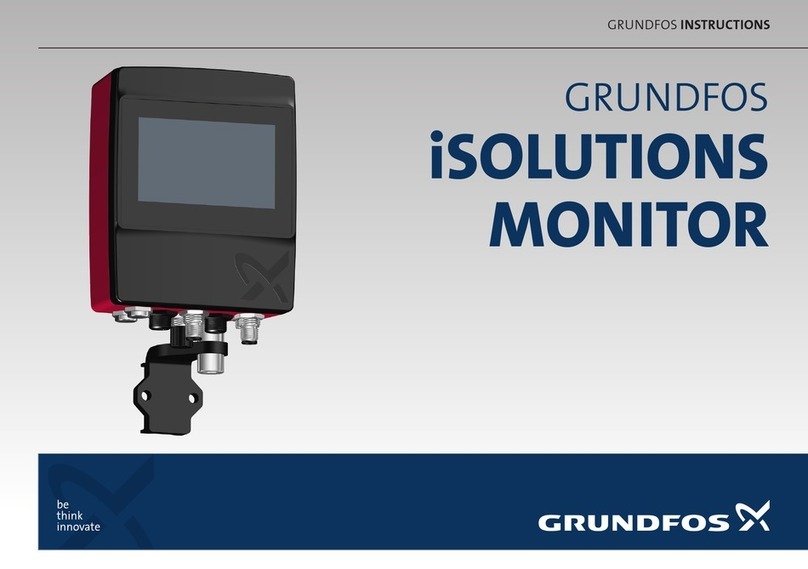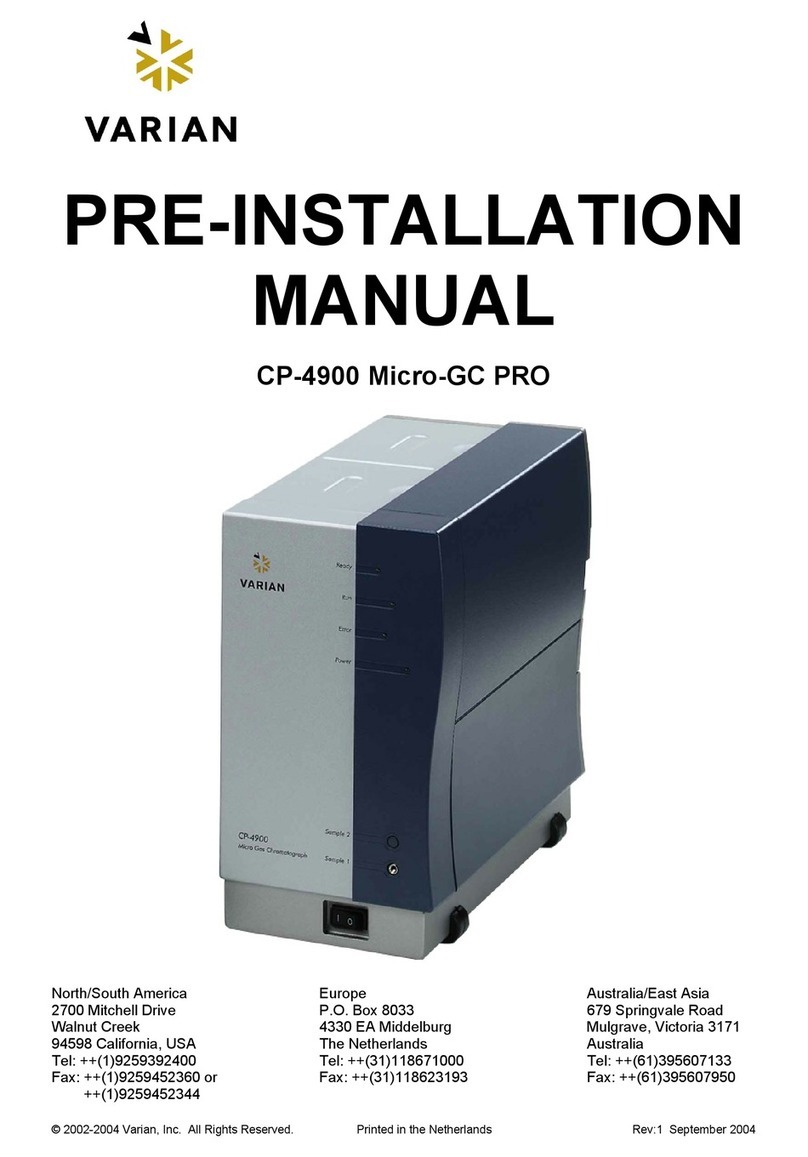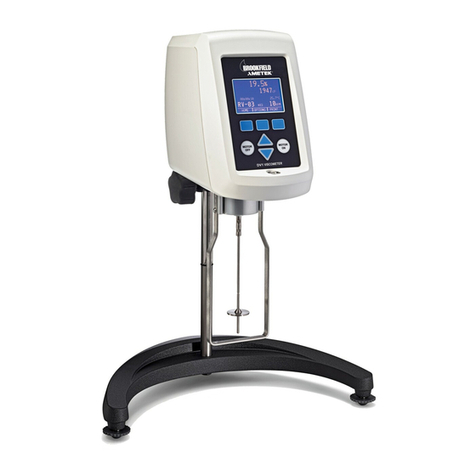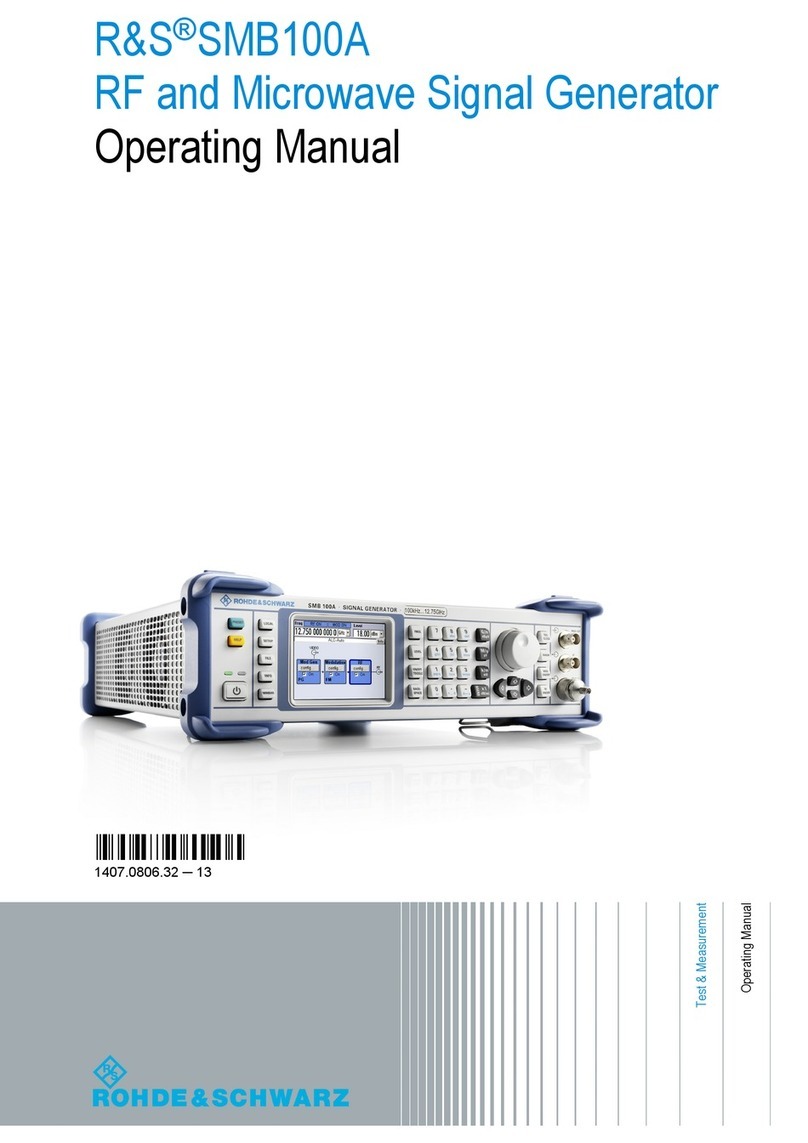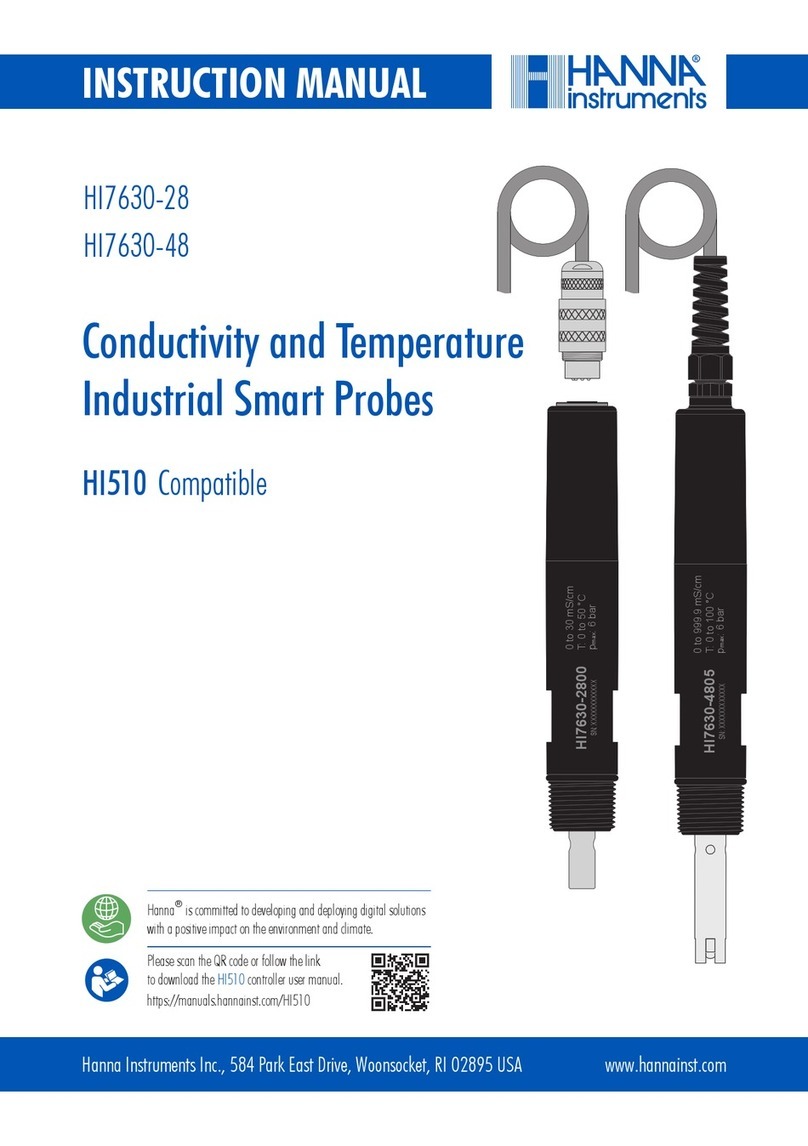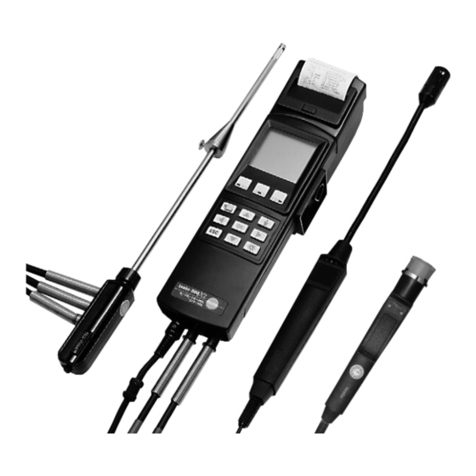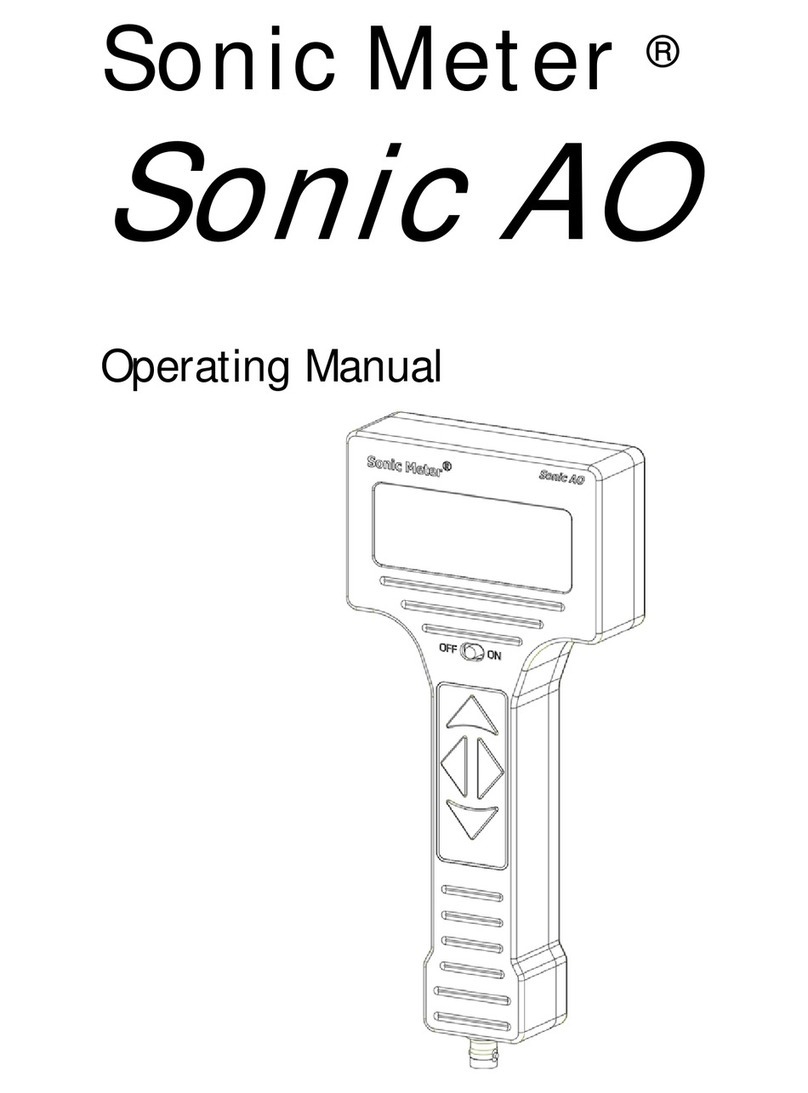KSE DCP K-100 User manual

DYNAMIC CONE PENETROMETERS
USER’S
MANUAL
All rights reserved by
Kessler Soils Engineering Products, Inc.
17775 Running Colt Place, Leesburg, VA 20175
SALES: (703) 569-2583 or (800) 569-7303
www.kesslerdcp.com
Meets ASTM D6951
PATENT NO. 5,313,825
K-100 Models
WITH QUICK CONNECT PIN
KSE DCP

DO NOT
PUT HAND NEAR
THE ANVIL WHEN
HAMMER IS RAISED
KEEP ONE HAND ON
THE HANDLE WHILE
OPERATING
THE DCP
SAFETY NOTICE
ALWAYS SECURE THE HAMMER AND/OR
THE ASSEMBLED DCP INSTRUMENT
WHEN PLACING IT ON ANY FLAT ELEVATED SURFACE TO PREVENT
IT FROM ROLLING OFF AND CAUSING PERSONAL INJURY OR
DAMAGE TO THE INSTRUMENT.
Copyright ©2014 Kessler Soils Engineering Products, Inc.
All Rights Reserved, Printed in the USA

INDEX
Application 1
Description 3
Procedures 7
Correlations 14
Maintenance 28
References 28
Warranty 30
MANUAL FOR IN SITU STRENGTH OF SOILS
USING THE KESSLER DYNAMIC CONE PENETROMETER
PART I: DCP WITH VERTICAL SCALE
PART II: DCP WITHOUT VERTICAL SCALE
Application 18
Description 19
Procedures 20
Correlations 22
Parts List 31
PART III

PART I
DCP With Vertical Scale

1. APPLICATION
1.1 This application describes measurement of the
penetration rate of the KESSLER DCP (Dynamic Cone
Penetrometer) with a Single-Mass or Dual-Mass Hammer
and quick-connect Drive Rod in field soil testing using a
Vertical Scale.
1.2 The KESSLER DCP is driven into the soil by
dropping either a Single-Mass 17.6 lb (8kg) Hammer or a
Dual-Mass Hammer from a height of 22.6 in (575mm). To
convert the Dual-Mass Hammer from a 17.6 lb hammer to
a 10.1 lb Hammer, remove the hexagonal set screw and
the outer steel sleeve (as shown in Fig. 2). The outer steel
sleeve is designed to slide over the DCP handle for ease of
conversion during testing. The cone penetration caused by
one blow of the 17.6 lb (8 kg) hammer is essentially twice
that caused by one blow of the 10.1 lb (4.6 kg) hammer.
The 10.1 lb (4.6 kg) hammer is used in weaker soils having
a CBR value of 10 or less and can be used on soils up to CBR
80. The 17.6 lb (8 kg) hammer penetrates high strength
soils quicker. The depth of cone penetration is measured at
selected penetration or hammer drop intervals and the soil
shear strength is reported in terms of DCP index. The DCP
index is based on the average penetration depth resulting
from one blow of the 17.6 lb (8 kg) hammer. The average
penetration per hammer blow of the 10.1 lb (4.6 kg)
hammer must be multiplied by 2 in order to obtain the DCP
index value from the correlation equation in paragraph 4.
1.3 The KESSLER DCP can be used to estimate the
strength characteristics of fine and grained soils, granular
construction materials and weak stabilized or modified
materials.
APPLICATION
1
Thank you for your purchase of a Kessler DCP (Dynamic Cone
Penetrometer), licensed to Kessler Soils Engineering Products, Inc.
by the U.S. Army Corps of Engineers (Patent No. 5,313,825).
The Kessler DCP is a durable and reliable Penetrometer
designed for field soil testing and measuring.

2
APPLICATION
575 mm
22.6 in
Anvil with
Quick-Connect Pin
Ve
Upper Rod
Handle
Upper
Attachment
Foot
Variable
30, 37.75, 40 in
Drive Rod
5/8 in (16 mm) diameter
Single Mass OR Dual-Mass
Hammer
17.6 lb (8 kg) OR 10.1 lb (4.6 kg)
rtical Scale
Tip (Reusable
Hardened Point or
Disposable Cone)
Figure 1–Schematic of DCP Device

1METHOD ST6 (1984) Measurement of the In Situ Strength of Soils by the Dynamic Cone
Penetrometer (DCP) (1984) Special Methods for Testing Roads, Draft TMH 6, Technical
Methods for Highways (TMH), Pretoria, South Africa. ISBN 0 7988 2289 9,Page 20.
Figure 2–Dual-Mass Hammer
1.4 The KESSLER DCP can be used to estimate the
strength of in situ materials underlying a bound or highly
stabilized layer by first drilling or coring an access hole.
NOTE: The DCP may be used to assess the density of a fairly uniform material by
relating to penetration rate on the same material. In this way under compacted
or ”soft spots“ can be identified, even though the DCP does not measure density
directly.
A field DCP measurement results in a field or in situ CBR and will not
normally correlate with the laboratory or soaked CBR of the same material. The
test is thus intended to evaluate the in situ strength of a material under existing
field conditions.1
2. DESCRIPTION
2.1 The KESSLER DCP in Fig.1 consists of an upper
assembly with a Single Mass or Dual-Mass Hammer (Fig. 2),
a Drive Rod and a tip. The Drive Rod is held in place with a
Quick-Connect Pin (Fig. 3) through the anvil. The tip consists
of an Adapter and Disposable Cone (Fig. 4) or reusable
Hardened Point (Fig. 5). The DCP is constructed of stainless
steel, with the exception of the tip. The Hardened Points
and the Adapters for the Disposable Cones are heat treated
steel. The Disposable Cones are plated steel.
DESCRIPTION
3
17.6 lb (8kg) Hammer 10.1 lb (4.6kg) Lower Hammer

DESCRIPTION
4
Upper rod
Anvil
Quick connect pin
Drive rod
End cap
Figure 3–Quick Connect Assembly
(Patent Pending)

Figure 4–Adapter with two Disposable Cones
Figure 5– Reusable Hardened Point
2.2 The instrument is manufactured to the following
specifications:
(1) Hammer weight measurement of 17.6 lb (8kg)
tolerance is 0.022 lb(0.010kg).
(2) Hammer weight measurement of 10.1 lb
(4.6kg) tolerance is 0.022 lb (0.010kg).
(3) Drop of hammer measurement of 22.6in (575
mm) tolerance is 0.039 in (1.0 mm)
(4) Tip included angle measurement of 60
degrees; tolerance is 1 degree.
(5) Tip base diameter measurement of 0.790 in
(20 mm); tolerance is 0.010 in (0.25mm)
DESCRIPTION
5
NOTE: The Disposable Cone tip shown in Figure 4 is held in place with an
o-ring. Use Disposable Cone tips in hard and cohesive soils to allow easy
extraction of the instrument. The Disposable Cone tip is designed to slide off
the Adapter when the Drive Rod is pulled upward after completion of the test.

DESCRIPTION
6
DESCRIPTION
6
DESCRIPTION
6
2.3 Replacement and Optional DCP equipment can be
found at www.kesslerdcp.com, including:
- 12”, 30” and 37.5” Drive Rods
- 48” Drive Rod
- 12” and 24” Extension Rods
- Magnetic Ruler
- Magnetic Ruler Printer
2.4 Other equipment used to make an access hole
through a bound layer may include:
- a rotary hammer drill or coring appartus capable of
drilling a minimum diameter hold of 1 inch (25mm).
A larger hold make be required depending on the
underlying material or the need for additional tests
or sampling.
- a wet/dry vacuum or suitable alternative to
remove loose material and fluid if an access
hole is made before testing.
- a field power supply to power above items.

3. PROCEDURES
3.1 Equipment Check
3.1.1 Before beginning a test, check to ensure the
Drive Rod is straight by rolling the rod on a flat surface.
Note: The Drive Rod may bend if driven beyond refusal
(see para 3.3.3).
3.1.2 The Hardened Point must be checked to ensure
the 3 mm flat is discernible. The flat area will become
rounded after about 250 tests and the tip should be
replaced. Rarely, if ever, does the Hardened Point wear to
the extent that the diameter fails to meet specifications
(see para 2.2).
3.1.3 The Adapter o-ring should be should be clean and
free of cuts or nicks. Each pack of 25 Disposable Cones con-
tains a replacement o-ring.
3.2 Assembling
3.2.1 Vertical Scale- Secure the black delrin Upper
Attachment by tightening the screw just below the end
cap. Next, place the foot over the end of the Drive Rod.
Slide the Vertical Scale through the square hole in Upper
Attachment and into the foot.
3.2.2 Tip- Tighten the tip securely with the wrenches.
3.2.2.1 The reusable Hardened Point is used in soft, non-
cohesive material, i.e. where the DCP advances more than
1/2” per blow (CBR <18%).
3.2.2.2 The Adapter and Disposable Cones should be
used for cohesive material and material where the DCP
advances less than 1/2” per blow (CBR >18%). Attach the
disposable cone to the adapter by applying pressure and
rotating the cone. This will ensure proper seating and
extend the life of the o-ring.
3.2.3 Drive Rod (30”, 37 3/4”, or 48”)- Slide the Drive
Rod into the anvil, insert the Quick-Connect Pin and
retainer clip. Treat the drive rod with a light film of oil
to minimize skin friction. This is especially important in
cohesive soils.
7
PROCEDURES

3.2.4 Drive Rod (12”) with 12” or 24” Extension- Use
only for material where DCP advances more than
1” per blow (CBR < 8%) and always use Disposable
Cones. Screw one 12” or 24” Extension Rod into the
12” Drive Rod and tighten with wrenches. Reassemble
DCP hammer assembly and restart the test. The test can
be conducted to a depth of 6 feet by adding additional
Extensions Rods in a similar manner. If you are using the
US Army Corps of Engineers Excel template we provide
to reduce your data, it will be necessary to book each
22” segment of the test in a separate file as this template
cannot be modified. You may wish to use the equations
provided in paragraph 4.1 to make your own template.
3.2.5 Adding 12” or 24” Extensions- After the 12” Drive
Rod and 24” Extension have been advanced, disconnect
the Drive Rod from the anvil and the Extension Rod. Screw
the second Extension Rod into the rod in the ground and
the Drive Rod using wrenches. Reassemble DCP hammer
assembly and restart the test. The test can be conducted to a
depth of 6 feet by adding the Extensions in a similar manner.
If you are using the Excel template we provide from the
US Army Corps of Engineers to reduce your data, it will be
necessary to book each 22” segment of the test in a separate
file as this template cannot be modified. You may wish to
use the equations provided in paragraph 4.1 to make your
own template.
3.3 Testing Sequence
3.3.1 Dropping the Hammer- Hold the DCP device
in a vertical position. Raise the Hammer until it touches,
but does not impact, the handle. Allow the Hammer to
fall freely and impact the anvil coupler assembly. Record
the number of blows and corresponding penetration as
described in paragraph 3.6.
3.3.2 Depth of Penetration- The depth of penetration
will vary with application. For typical highway applications,
a penetration of less than 692 mm (27 1/4 in) will generally
be adequate. In soft soil, the DCP may be advanced to 6
feet (See PROCEDURES para 3.2.4 and 3.2.5).
PROCEDURES
8

3.3.3 Refusal- The presence of aggregates > 2” or rock
strata will either stop further penetration or deflect the
drive rod. If, after 3 blows, the device has not advanced
more than 0.08 in (2 mm) or the handle has deflected
more than 3 in (75 mm) from the vertical position, stop
the test and move the device to another test location.
Continuing to drop the hammer will damage the
instrument. The new test location should be a minimum
of 12 in (300 mm) from the prior location to minimize test
error caused by disturbance of the material.
3.3.4 Extraction- Following completion of the test,
extract the device by driving the hammer upward against
the handle. Use a smooth upward movement and do
not throw the hammer against the handle.
3.4 Caution
• DO NOT drop the hammer after refusal.
• DO NOT throw the hammer upwards.
• DO NOT rock the DCP side to side or forward and
backward in an attempt to loosen it from the ground.
3.5 Initial Reading
3.5.1 Testing a surface layer- Hold the DCP vertically
with the top of the widest part of the tip flush with the
surface of the material to be tested. Take an initial read-
ing from the Vertical Scale, measuring the distance to the
nearest 1 mm (0.04 in).
3.5.2 Testing below a bound layer- When testing mate-
rials underlying a bound layer, a rotary hammer drill or
coring apparatus meeting the requirements given in para-
graph 2.4 is used to provide an access hole to the layer
to be tested. Wet coring requires that coring fluid be
removed immediately and the DCP test be performed as
soon as possible. The coring fluid must not be allowed to
9
PROCEDURES

soak into or penetrate the material to be tested. A wet/dry
vacuum or suitable alternative is used after completion of
drilling or coring to remove loose material and fluid from
the access hole before testing. To minimize the extent of
the disturbance from the rotary hammer, drilling should
not be taken completely through the bound layer, but
stopped short by about 10 to 20 mm. The DCP is then used
to penetrate the bottom portion of the bound layer. This
can be a repetitive process between drilling and doing DCP
tests to determine the thickness of the layer.
3.5.3 Testing pavement with thin seals — For pavements
with thin seals, the tip is advanced through the seal until
the top of the widest part of the tip is flush with the layer
to be tested.
3.5.4 Once the layer to be tested has been reached- A
reference reading is taken with the cone zero point at the
top of that layer and the thickness of the layer(s) cored
through recorded. This reference reading is the point from
which the subsequent penetration is measured.
3.6 Recording Methods
3.6.1 Two person, traditional method (Figure 6A)-
When many tests are to be taken, it is best to have two
people operating the DCP and recording the data. The
recorder reads the scale at the top of the attachment or
holds the Vertical Scale to the bottom of the widest part
of the hammer and measures/records the cumulative pen-
etration for the number of blows in a set. The set is the
number of blows it takes to advance the DCP about 2 in (50
mm). The data is recorded on the DCP data sheet.
3.6.2 One person with Vertical Scale (Figure 6B)- Apply
blue removable tape along the side of the Vertical Scale
adjacent to the mm markings. Insert the Vertical Scale
through the Upper Attachment and into the Foot. At the
end of each set, the operator marks the position of the top
edge of the Upper Attachment by drawing a line along it
on the blue tape, and writes the number of blows required
next to the line. After the test, the operator enters the
PROCEDURES
10

cumulative penetration and number of blows between
marks on a DCP data sheet or in the Excel template.
11
PROCEDURES
Figure 6A–Two person,
traditional method
One person operates
DCP while the other
person records
penetration rate
Figure 6B–One person
One person operates
DCP, then marks the
tape on the Vertical
Scale.

12
PROCEDURES
3.6.4 Magnetic Ruler (Figure 7)- The optional Magnetic
Ruler is a battery-operated AAA (Qty. 6), data-collection
device for the Dynamic Cone Penetrometer (DCP). It
displays depth, blows, mm/blow, cumulative mm/blow , and
cumulative blow/inch in SI and English. The correlations
are CBR (California bearing ratio) in %; Bearing capacity
in Kips per square foot, and unconfined compression test
in %. A flash drive records the data, information entered
by the operator, and date and time for each test via a
waterproof USB port.
3.7 Data Recording
A form like the one shown in Figure 8 is suggested for data
recording. The recorder enters the header information
before the test.
(1) The actual test data is recorded in column 1
(Number of Blows) and column 2 (Cumulative Penetration
in mm); if the moisture content is available, it is entered in
column 8.
(2) When testing a subsurface layer through a
drilled or cored access hole, the first reading corresponds
to the referenced reading at the top of the layer to be
tested.
(3) The number of blows between readings may
be varied depending on the resistance of the material.
Normally readings will be taken approximately every 50
mm (2”), i.e. 1 blow for soft material, 5 blows for “nor-
mal” materials and 10 blows for very resistive materials.
(4) The tip should be advanced a minimum of 25
mm (1.0 in) between readings. The penetration to the
nearest 1 mm (0.04 in) corresponding to the specific num-
ber of blows is recorded. A reading is taken immediately
when the material properties or rate of advance change
significantly.

13
PROCEDURES
Figure 7–Magnetic Ruler

Instruction for Data Recording Sheet:
(1) Number of hammer blows between test readings
(2) Cumulative penetration after each set of hammer blows
(3) Difference in cumulative penetration (2) between readings
(4) (3) divided by (1)
(5) Enter 1 for 17.6lb (8kg) hammer; 2 for 10.1 lb (4.6kg) hammer
(6) (4) x (5)
(7) From CBR verses DCP Index correlation
(8) % Moisture content when available
14
CORRELATIONS
4. CORRELATIONS
4.1 The CBR may be estimated using the DCP index
(column 6 on the DCP Data Sheet) and Table 1 for each
set of readings. First, the DCP index is computed for
the respective penetration between readings. The
penetration per blow is then used to estimate in situ CBR
or shear strength using the appropriate correlation for
the reference. For example, the correlation of penetration
per blow (DCP) in Table 1 is derived from the equation
CBR = 292 / PR1.12 recommended by the US Army Corps
of Engineers. This equation is used for all soils except for
CL soils below CBR 10% and CH soils. For these soils, the
following equations are recommended by the US Army
Corps of Engineers, where PR is the DCP penetration rate
in mm per blow: 3
CL soils CBR < 10: CBR = 1 / (0.017019*PR)2
CH soils: CBR = 1/ (0.002871*PR)
Selection of the appropriate correlation is a matter of
professional judgment.
4.2 The Modulus of Rigidity MRmay be estimated
using between 1300 to 1500 CBR.
4.3 If a distinct layering exists within the material test-
ed, a change of slope on a graph of penetration/blow vs.
depth will be observed for each layer. The exact interface
is difficult to define because, in general, a transition zone
exists between layers. The layer thickness can be defined
by the intersection of the lines representing the average
slope of adjacent layers. Once the layer thicknesses have
been defined, the average penetration rate per layer is
calculated.
4.4 The EXCEL™template on the enclosed CD will graph
the results of the test. (See instruction sheet included on
CD). It will also plot a correlation of CBR to PSF (lbs/sq. ft).

DCP DATA SHEET
Project: Forest Service Road
Location: STA 30+50, 1 M RT of C/L
Depth of zero point below: 0
Material Classification: GW/CL
Pavement conditions: Not applicable
Date: 7 July 2005
Personnel: JLS & PAK
Hammer Weight: 17.6lb (8kg)
Weather: Overcast, 25°C, (72° F)
Water Table Depth: Unknown
(1)
Number
of
Blows
(2)
Cumulative
Penetration
(mm)
(3) (4) (5)
Hammer
Blow
Factor
(6)
DCP
Index
mm/blow
(7)
CBR
%
(8)
Moisture
%
0
5
5
15
10
5
5
10
5
5
5
5
0
25
55
125
175
205
230
280
310
340
375
435
--
25
30
70
50
30
25
50
30
30
35
60
--
5.0
6.0
4.7
5.0
6.0
5.0
5.0
6.0
6.0
7.0
12.0
--
1
1
1
1
1
1
1
1
1
1
1
--
5.0
6.0
4.7
5.0
6.0
5.0
5.0
6.0
6.0
7.0
12.0
--
50
40
50
50
40
50
50
40
40
35
18
Figure 8–DCP Data Sheet 2
1
2
3
4
5
6
7
8
9
10
11
12
2
Webster, S.L., Grau, R.H. Williams, T.P., (May 1992), Description and Application of
Dual mass Dynamic Cone Penetrometer, Report GL-92-3, Department of the Army, Washington
D.C., Pg. 19
CORRELATIONS
15
Penetration
Between
Reading
(mm)
Penetration
per
Blow
(mm)

73Webster, S.L., Brown, R.W., Porter, J.R. (April 1994), Force Projection
Site Evaluation Using the Electric Core Protection (ECP) and the Dynamic Cone
Penetrometer (DCP), Technical Report No. GL-94-17, Air Force Civil Engineering
Support Agency, U.S. Air Force, Tyndall Air Force Base, Florida
3
Table 1–Tabulated Correlation of CBR versus DCP Index
DCP Index
mm/blow CBR
%
DCP Index
mm/blow CBR
%
DCP Index
mm/blow CBR
%
<3
3
4
5
6
7
8
9
10-11
12
13
14
15
16
17
18-19
20-21
22-23
24-26
27-29
30-34
35-38
100
80
60
50
40
35
30
25
20
18
16
15
14
13
12
11
10
9
8
7
6
5
39
40
41
42
43
44
45
46
47
48
49-50
51
52
53-54
55
56-57
58
59-60
61-62
63-64
65-66
67-68
4.8
4.7
4.6
4.4
4.3
4.2
4.1
4.0
3.9
3.8
3.7
3.6
3.5
3.4
3.3
3.2
3.1
3.0
2.9
2.8
2.7
2.6
69-71
72-74
75-77
78-80
81-83
84-87
88-91
92-96
97-101
102-107
108-114
115-121
122-130
131-140
141-152
153-166
166-183
184-205
206-233
234-271
272-324
>324
2.5
2.4
2.3
2.2
2.1
2.0
1.9
1.8
1.7
1.6
1.5
1.4
1.3
1.2
1.1
1.0
0.9
0.8
0.7
0.6
0.5
>0.5
16
CORRELATIONS
Table of contents
Popular Measuring Instrument manuals by other brands

Sea-Bird Scientific
Sea-Bird Scientific WQM-a user manual
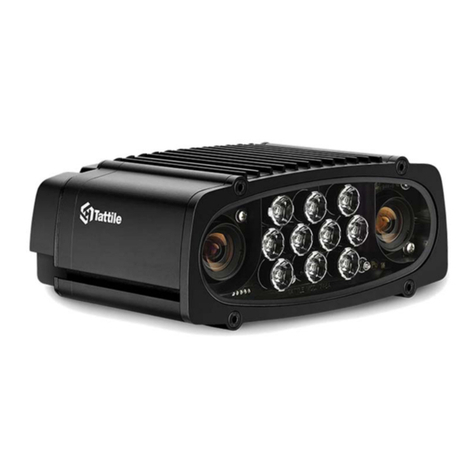
Tattile
Tattile ANPR MOBILE Series Original Installation Instructions

Panasonic
Panasonic SV-3800 operating instructions

PCE Instruments
PCE Instruments PCE-VA 11 user manual

TESTO
TESTO Smart Probes 905i instruction manual
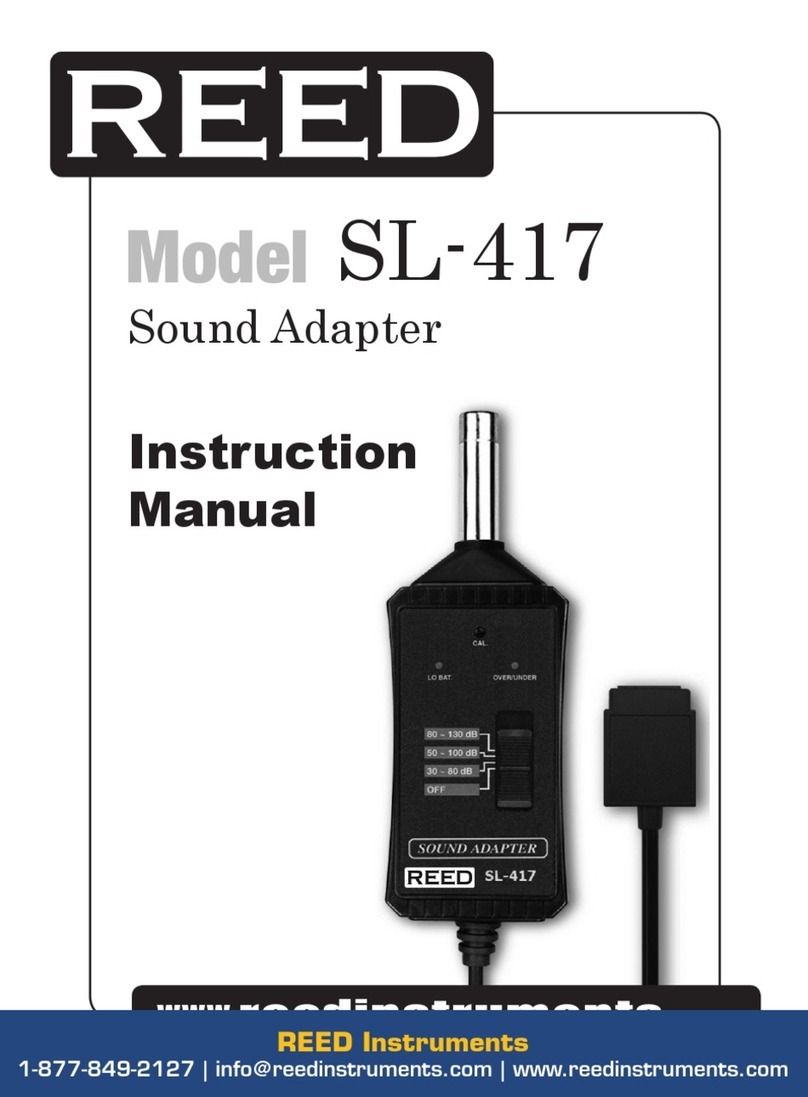
Reed Instruments
Reed Instruments SL-417 instruction manual

